It’s been a long time and a different life since I last visited Norwich but Heather and I returned there (it had been even longer for her), mainly thanks to a game of “where are the trains actually running to” over Easter. Turns out there are way more churches than I remember, but we still had a lovely time.
The trains were indeed running, and so took us from Liverpool Street up into Norfolk (the train was fine, but seemed to be full of wandering people walking up and down it, and a man who really wanted to use the toilet, except for the one time it was clearly available—Norfolk is always a bit strange). Arriving into Norwich we did what I think must be the tradition and headed across the road from the station to The Compleat Angler sitting just beside the bridge by the station on the river. There we rested and planned out which way around and into Norwich we would be going over the coming days before crossing the street and finding the hotel (who managed to let us into our room a bit early).

Arcade
The very pretty shopping arcade
Up the hill and into Norwich and we could begin to admire its varied architecture. There is of course the castle keep watching over all from the hill top (itself loomed over by a tower crane as it underwent works designed to allow visitors to see more of the medieval structure), but also the solid old halls and the like that dot the landscape with their Victorian and early twentieth century solidity. The city centre itself remains as compact as I recalled, arcing a little round the curve of that castle hill. There’s a pretty little shopping arcade of much decoration, and the strange permanent market stores stretching down from the imposing town hall. It was during our initial wanderings that we first made what would become a regular call, The Bell Hotel occupying a prominent position near castle and town, and offering welcome reliable relief.

All Saints
Now an antigues centre
We went from there up hill, climbing the picturesque Timber Hill and following the road around past the quite art deco John Lewis almost at random. It was around then we began to realise just how many churches Norwich possesses. Granted not all remain as actual religious establishments these days (though a large number seem to) but still. Several of the guidebooks claim Norwich once boasted a pub for every day of the year and a church for every week but the experience now is more that the claim should be the other way around!

Fancy Offices
Norwich Union’s old headquarters
Our walking took us as far as the ring road, never quite establishing what the pointy, non-church building we could see is, before we headed back down into the city centre proper, passing the impressive Norwich Union buildings. In town our weary feet were rested in the Lamb Inn (which seems to have escaped my attention on previous Norwich visits, despite its delightful courtyard outside). There we began to think about dinner, so when we started to wander again it was with half an eye on restaurant menus as we passed them. It was still a little bit early though so our walking too us in something of a loop until we were sat once again in the Bell contemplating options.
One possibility had stood out and we were lucky enough to find online booking allowing us to hold a table for a time just enough in the future to allow us to walk back down. Bishops turned out to be an excellent choice, with wonderful food and great service (and cocktails). Highly recommended if you find yourself in Norwich.
Well fed and stuffed we wandered back towards the hotel, down the slightly disturbing Prince of Wales Road, home to the peculiar night life of Norwich. The Angler wasn’t too insane though, and provided a welcome night cap before heading to bed.
Being an Easter break it seemed wise to time any visit to religious establishments of a Christian leaning to avoid Good Friday and Easter Sunday, lest we find them full of the mindless mystic in the sky sort. Saturday seemed a good bet to go and look at the cathedral then, so it was we decided to head out along the river in that general direction.
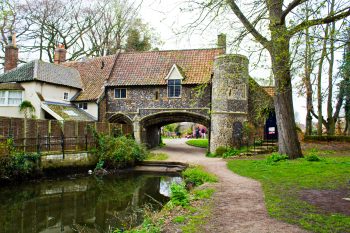
Furry House
The prettiest bit of Norwich
The walk along the river from the Anglers (who’s beer garden forms part of the path) has always seemed a nice one, such that even light rain couldn’t dampen it. The riverside walk allows one to enjoy the boats going by, and occasional water bird, despite the busy road just the other side of the river. Soon we found ourselves at what may well be the prettiest spot in Norwich. Pulls Ferry looks like something taken from a fairytale. Originally a watergate, a canal once ran through its arch to allow stone to be transported from the river for the building of the cathedral. The canal is gone but a ferry operated across the river for centuries, John Pull being a nineteenth century ferryman. It’s a delight, and always a joy to remember that it’s restoration was partly funded by the girl guides!
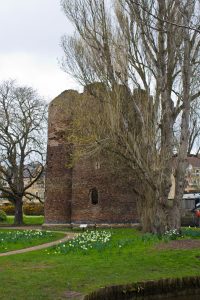
Cow Tower
Now cows in sight though
A little further along from Pulls Ferry is the medieval Bishop Bridge, offering fine views back down the river. At one end of the bridge is the Red Lion pub which we contemplated going in before deciding to delay for a bit, instead continuing along the river. Slightly further along, round the bend, is the somewhat mysterious at first glance Cow Tower. Today it sits in the middle of an almost park like bit of the riverside path, with not a cow in sight, towering silently and with no obvious purpose. It’s actually a very early example of a purpose built artillery blockhouse, commanding the river and riser up to counter the high ground on the opposite side. It’s long fallen into being an (inaccessible) empty shell and home to many pigeons. In a tree next to it is a peculiar piece of art, something of a tower block of bird houses.
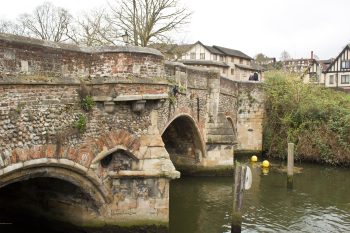
Bishop's Bridge
A nice old river crossing
From the Cow Tower we were going to follow the river and cross Whitefriars Bridge to come back the other side. As it was we never got that far around because these days the sweeping Jarrold Bridge exists to provide a walking route across. So it was we looped back round to come along the opposite river bank, giving fine views of the other side of the Cow Tower. It also gave us a chance to see up close the Egyptian geese and goslings we’d spotted hanging out in the grass there. Reaching Bishop Bridge again we crossed back over and this time did stop at the Red Lion, for a fine lunch (outside proved slightly too windy but the conservatory was perfect, with a view of the paddle boarders setting off from beside the pub).
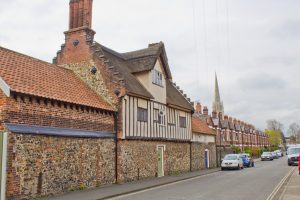
Old Building
Here and there are a number of timber framed buildings
Much refreshed we followed the road up from the bridge, a quiet and pretty route leading to the cathedral, who’s tower was easily seen from beside the river. Before heading into its bulk we hovered outside to pay respects at the grave of Edith Cavell (I’ve actually seen the railway van which repatriated her body following the war).

Courtyard
The cloisters of the cathedral
Entering the cathedral proper we found ourselves wandering the cloisters, complete with hundreds of roof bosses. The sun bathed grass in the centre was empty of anyone following the meditative spiral path at its centre as we made our own circle back around to the main bulk of the cathedral. Near the doors back in were a row of fading arms painted on the walls, a 1930s repainting of those placed there to commemorate the visit of Queen Elizabeth I (and those with her) in the sixteenth century.

Aspe
The towering end of the cathedral
Completing the circuit and into the cathedral proper we walked around marvelling at its size and scale—much larger than the former churches turned cathedral of say Newcastle. In fact so large is it that it took us a little while to realise that what we were wandering was the nave, a large proportion—what felt like a whole other church—hidden beyond. The place is truly massive, and an impressive feat of medieval building. Its soaring heights designed to inspire awe and wonder climb over the more human scale of the quire. It took us quite a while to wander around it all and find our way back to the little shop.
Outside is a large green buttressed by statues of the great heroes Wellington and Nelson, with (of course for this city) yet another church off to the side. Two impressive gates give entrance from the city outside into the green, and so we headed out through one of these, past a memorial to Cavell, to find rest in the Louis Marchesi across the way (Marchesi founded the Round Table of Britain and held some of the first meetings here apparently). It’s a cosy little pub, creaking with its age and possibly in need of some investment, but friendly enough.

Looking Back Down The Hill
Not quite as pretty as Mermaid Street
From there we had a poke around Tombland (named for open spaces, not graves, everything is eager to point out) and headed down the road to the river. Standing on the Fye Bridge we were quite amazed to see what was clearly a bat circling around the water in broad daylight. We watched in delight, and failing to get a decent photograph, for a while before heading up the cobbled street which is the ancient Elm Hill. It’s reminiscent of Mermaid Street in Rye, though without the quirky house names and excellent pub. Still, the little open space with hand pump still feels like it could be any time in the last few centuries. We noodled around the shops there before heading around the rear of yet another church to look along the river again. There we were rather surprised to see the remains of a complex once belonging to the Blackfriars (the only hint really is the car park occupying the area is called Monastery). Now an events venue the remains include the large church halls and it’s actually the most complete surviving medieval priory in England!

The Adam And Eve
Norwich’s oldest pub
Our wandering took us back round to cathedral, calling in at the neat little herb garden, and onwards through the quite streets to the oldest pub in Norwich. The Adam and Eve started life as a brewhouse serving those working on the building of the nearby cathedral. It still retains a quirky, cramped interior (and sunny outside) steeped in history. Well worth the slight detour to go and find it.
After that pub we went wandering in search of another. There was a slight pause to peer at the Bishop’s house through the walls around the cathedral complex, and then we stumbled into The Wig and Pen, an old pub that feels added to across the years. We enjoyed a pint or two there before heading to find some dinner. We thought you probably couldn’t go much wrong with a half decent Italian restaurant (I miss Fiagros) and so settled on Trattoria Rustica. To be fair the food itself was fine but come time to leave we regretted the decision. I had to go and find someone to ask for the bill, and then find someone again to remind them we’d asked ten minutes ago. By the third time I ended up marching to the far end of the restaurant where, rather than a profuse apology the (I presume) proprietor decided to argue and try and defend his staff’s complete absence (it was obvious from the way he turned with a panic query to the staff as to which table he’d realised a cock up on my approach, and his argument that they didn’t like to thrust the bill upon customers didn’t hold water when they’d been asked twice to bring it and left us waiting near twenty minutes). The whole thing put a slight damper on the evening, so we simply retired to the hotel ready for another day.

Swans A Swimming
Too many of them!
Given the number of churches around the city centre it didn’t seem like a good place to head on Easter Sunday. Instead we set out from the hotel the other way along the river, intent on visiting a bit of medieval history and finding a favourite activity. The river the “wrong way” seemed to mainly full of swans, looking splendid in the warm morning sunshine. We came up to another of Norwich’s newer bridges, the Lady Julian Bridge and had a wander across to the far bank and up the hill. That brought us to admire the outside of Dragon Hall (I seem to remember just wandering around it on a previous visit, but now it appears to be home of The National Centre For Writing). It’s another of Norwich’s buildings that has a feel of Stratford upon Avon about it—it’s easy to imagine Shakespeare would have felt at home visiting.

Little Church
One of Norwich’s smaller religious buildings
A little further up the hill we found a neat little church, much smaller and human scaled than those further into the city centre. There, while Heather was exploring the interior, I was wished “happy Easter” by a passing priest (almost as an after thought it felt), the one brush with the religious holiday we’d actually have! We decided to abandon going up the hill any further because we really did want to make it further along the river, so walked our way back down and across the bridge to head towards our destination.
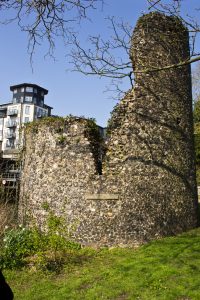
Tower In The Sun
A bit fallen down now
That destination were the two medieval boom towers, either side of the river, which once spanned a chain between them to control river traffic. As we approached a friendly elderly lady engaged us in conversation about the Egyptian goose nestled on the far bank, wondering how many young she had. It was quite difficult to tell but, after later examination of photos, I think the answer was actually none!
We said goodbye to the curious local and went to more closely examine the tower on our side of the river. These days it’s a plant covered ruin almost totally tumbled down on the river side, which offers a view into its hollow pigeon filled interior. Across the water its companion is even more buried beneath vegetation. There’s a road bridge next to the towers so we decided to cross for a better look at the far side. The bridge itself is interesting, having been built around a hundred years ago to replace a previous bridge, and in theory being on opening bridge (the traffic control lights are there, and old control cabin, though there seems to have been some controversy over sealing it closed recently.

Boom Towers
Both towers from the nearby bridge
The tower on that side of the river is slightly trickier to get to as the town walls run down to it, so one has to climb the hill a bit and gain the far side to come back down to the tower. It’s become even squatter than its compatriot is these days, and much harder to get a sense of from beside it. We headed back up the hill (somewhat regretting having come down it!) and stood on the bridge to take them, and a passing swan, both in.
Having looked at the towers, we tried to find our next activity for the day. Unfortunately Google simply is wrong about where it is! So we found ourselves orbiting a leisure centre in confusion before deciding to head back along the river and retire to the outside decking of The Queen Of Iceni to work things out. There it became obvious, and a quick bit of recognisance confirmed, that whatever Google Maps thinks, Mr Mulligan is at the end of the shops complex near the station and not somewhere in a swimming pool.
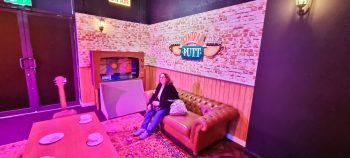
Lazing Around In Central Putt
Another golfing hole
Finally at the correct place we had a round of crazy golf. It’s a new course, and feels in places like it’s trying a little too hard. While the Friends themed hole is entertaining, there’s one hole for instance that doesn’t even involve using the clubs (a tilt table taking the place of anything more traditional) and another with a table football thing allowing opponents to “defend” the otherwise rather simple hole in one, which isn’t really in keeping with the game. A bit hit and miss then (they’re fancy electronic scoring also wasn’t working—good job there’s nothing wrong with pencil and scorecard).
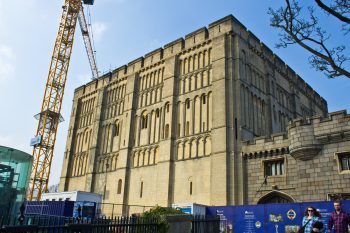
Castle Being Renovated
The medieval part was closed for refurbishment
On finishing and emerging into the still brightly sunny day we’d essentially done a tight loop by the river, and so called into the hotel for a bit of a rest. We needed a bit of energy because we were going up the hill again, this time to the castle. Though most of the interesting parts (i.e. medieval) parts were closed for the mentioned works, there are still fine views of Norwich to be had from around the exterior of the keep, and the rest of the museum was available to look round, occupying the former prison area.

The Many Teapots
One of the castle museum’s most notable features
The museum is mostly full of local art and, the thing I most recalled from my last visit and was delighted to know was still a thing, a massive collection of teapots. They have a teapot of the month. Make of that what you will. There was also a half interesting exhibition on the sinking of the Gloucester, a seventeenth century warship which went down off the Norfolk coast with the future king on board (he got off). And upstairs from the central shop a little art exhibition which was more than coastal landscapes. That little shop itself was a bit disappointing—though Heather found a thimble, so all was well. We’d managed to kill an afternoon in the museum anyway, and so could find our way out and, almost inevitably, to the Bell for a drink.
There we again made plans, not wanting anything too taxing for the evening, and so headed back once again towards the hotel and across the road to the Angler for dinner. That was nice enough but we wanted a slightly better pub before bed so had a night stroll along the river to relax in the Red Lion for a bit. That meant we could walk the other side of the river back, something I’ve don’t think I’ve done before and gave the chance to view Pulls Ferry from across the water.
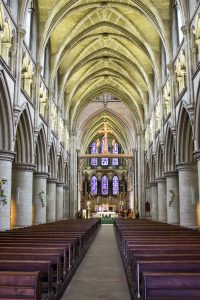
Aisle
In the RC Cathedral
Monday saw us heading out to reach some of the other things on our “to see” list, including those a bit further out. First though we had to start in the Bell, as had become almost habit, for a bit of planning. We started with a mooch around the Forum area, and the outside of the looming St Peter Mancroft, trying to see its famous wooden spire at the top of the tower through the rain. From there we made our way around the little streets near the guild hall, and up St Giles Street. After just a few more churches we reached, having navigated the busy roads cutting it off from the city proper, Norwich’s second cathedral. It’s obviously a lot more compact than the huge thing in the centre but still has quite an interesting interior, pretty in places, more human than bigger cathedrals. There’s also a very modern “narthex” which forms the modern entrance (yes, I had to look up narthex).
We left the cathedral and started on a large loop out into the suburbs. First we passed through Chapelfield Gardens, complete with wetly miserable fair, which gave a chance to see some more of the remains of the town walls. Old coaching inn The Coachmakers Arms gave some welcome respite from the rain, complete with a handful of Norwich fans on the way to the match, while we considered lunch options. In the end we headed further into the outskirts of Norwich, having picked out two or three possible options we headed through the quite, at times very pretty streets of houses. That brought us to The Pear Tree, which had an actual fire going and, although a slightly strange menu, delicious food.

Bright Gardens
The sun over plantation gardens
From there it was back along the road to complete the circle back to the cathedral. And from there we headed round the corner and down the road a bit to find a bit of Norwich I knew I had to show Heather. The Plantation Garden is a wonderful, tranquil, and beautiful spot hidden just off a main road. Constructed in an old chalk quarry by a successful nineteenth century businessman it’s a long, thin cut between houses, filled with lawn and planted beds. It’s character comes from the “gothic” and “medieval” features, really brick reliefs which were mainly available from local manufacturers. It’s a remarkable place, and even the Sun came out to cheer us.
Eventually we convinced ourselves to leave, and headed off away from the city aiming for, of course, a pub. First there was the somewhat poncy Black Horse which at least provided a break point in our wanderings. Further through the streets though lay our prize. The Fat Cat is a multi-award winning pub on the corner of a residential street. It was a compact, friendly place that captured us for a couple of good drinks.

The Round Tower
The rest of the church was bombed
Heading back into town we hunted out a lost church. St Benedict’s was bombed during the Second World War, leaving only it’s round (unusual for the churches of Norwich) tower standing. That now forms something of a surreal sight, sitting fenced off in the middle of a 1970s council estate, just glimpsed until one finds the way into the little patch of grass around it.
Having found the tower the road took us back past several more churches and once more into the city centre. There we found the Garnet, much prettier and nicer than I remember it being. On leaving I nearly left them a present, having to run back to retrieve my hat! We’d left to find food as it was getting late, settling on the hotel restaurant for a perfectly adequate meal before bed.

Old Chemist
An old pharmacy recreated
We’d originally not had much planned for the final day of our trip, mindful that we’d be needing to catch a train home. When we’d visited the castle museum however they’d given us a free entry ticket to The Museum of Norwich at the Bridewell (I’m not sure if that’s just what they do, or if it was some sort of compensation for half the castle being closed). So it was we decided to leave the cases in the hotel’s care and head out to find one last activity for the morning.
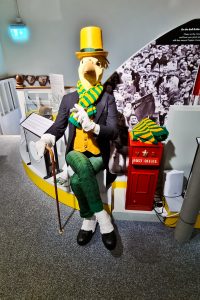
Scary Canary
Disturbing mascot
The museum is an industrial history of Norwich housed within a building with a coloured history. Starting life as a house, the site became a prison come workhouse, before being partly burnt down and rebuilt, still as a prison. It then became factory, warehouse, and finally a shoe factory (Norwich having a long tradition of shoe making), before finally becoming a museum. It’s current incarnation is a bit hit and miss, with the real interest scattered among the sort of things only someone into shoe making really likes. The undoubted highlight is the recreation of an early twentieth century pharmacy (particularly exciting for Heather), and the terrifying Norwich City canary mascot. Still, it killed a good part of the morning.
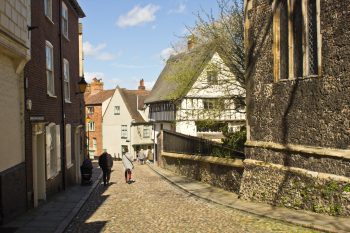
Sunny Elm Hill
The cobbles and shadows
After the museum we went to say goodbye to constant stop off point the Bell, before a little trip round the market again and down Elm Hill. That brought us to a last Norwich drink in the city’s third Wetherspoons, The Glass House, before we really did need to collect the cases and take them the short distance to the train home.
Of course back home we had to finish off with our own Wetherspoons, while planning the things we’d missed out this trip. We’ll try and catch them all next time we visit, once the castle is complete and open again.
Photos
There were many, many more photos
Ed Perkins responded: